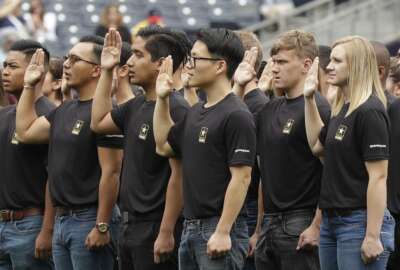
Air Force will need to shed nearly 5,000 medical billets to meet DoD’s plan to cut staff
The Air Force will make the reductions through attrition over three years if DoD pulls the trigger on the plan.
The Air Force will decrease its medical billets by nearly 5,000 positions over the next three years as part of a larger Defense Department effort to make the military more lethal, if the Pentagon goes ahead with the plan.
Lt. Gen. Dorothy Hogg, surgeon general of the Air Force, told Federal News Network the service will reduce its medical billets through attrition rather than pushing medical airmen out for the first three years, but may have to use other means after that time if the goal is not met.
“We have laid in the plan, but I have not executed it,” Hogg said. “The only thing I’m not doing in 2020 is filling vacant positions, and those are positions that have been vacant for a long time.”
DoD is holding off on executing the plan since there are some concerns from Congress about cutting medical staff.
The reduction is part of DoD’s larger strategy to convert 18,000 medical billets military-wide into other positions that are in need of manpower.
The Air Force will be responsible for 4,684 of those billet reductions, Hogg said.
“Every year we run what we call a critical operational readiness requirement model and that considers all of the readiness requirements and operational requirements the Air Force requires me to do and the combatant commanders need me to do,” Hogg said. “When that model gets done running all of its assumptions I get a number that tells me how many people I need in uniform to do my operational mission. I knew I was over in active-duty members in doing my operational mission. That excess is what was considered for reduction.”
The Air Force went facility by facility and looked at its capability and the capability of the surrounding area to see if there was availability in the market to handle reduced services from the military treatment facility.
The Air Force chose areas that could handle the decrease in service for the drawdown.
As medical staff retire or separate from the service, the Air Force will simply not fill those positions and put manpower in other areas.
“At the end of three years we will look to see what I have left and then I will have a discussion with our personnel folks and see what we will do after that,” Hogg said. “My desire is not to do any kind of force reduction so I will work with the personnel staff to see how we can do that still through normal attrition.”
Related Stories
The bill requires an analysis of each military treatment facility to mitigate potential gaps in health care.
It also requires DoD develop a standard measurement for communities will be affected by a reduction. DoD will need to provide each member of the military and covered beneficiary in an affected area with a transition plan for continuity of care and set up a public forum to discuss concerns.
Finally, DoD must provide Congress with a report of the reviews and analysis and a description of the plans for reduction of realignment.
DoD’s 2020 budget did not include funds to fill the billets with civilian positions.
The military services have long believed that having their uniformed medical personnel engaged in patient care in stateside military treatment facilities is key to maintaining a medical force that’s ready to deploy to combat zones.
But some of the specialties in demand at those stateside MTFs — like pediatricians and obstetricians — don’t match well with the military’s battlefield medical requirements.
An assessment published last May by the Institute for Defense Analyses noted that the military “over-staffs” positions needed to care for family members and retirees, and has a deficit of general surgeons and emergency physicians. IDA estimated DoD could save more than $1 billion over five years by converting military positions that provide care in just eight specific specialties to civilian health jobs.
Copyright © 2025 Federal News Network. All rights reserved. This website is not intended for users located within the European Economic Area.
Scott Maucione is a defense reporter for Federal News Network and reports on human capital, workforce and the Defense Department at-large.
Follow @smaucioneWFED





